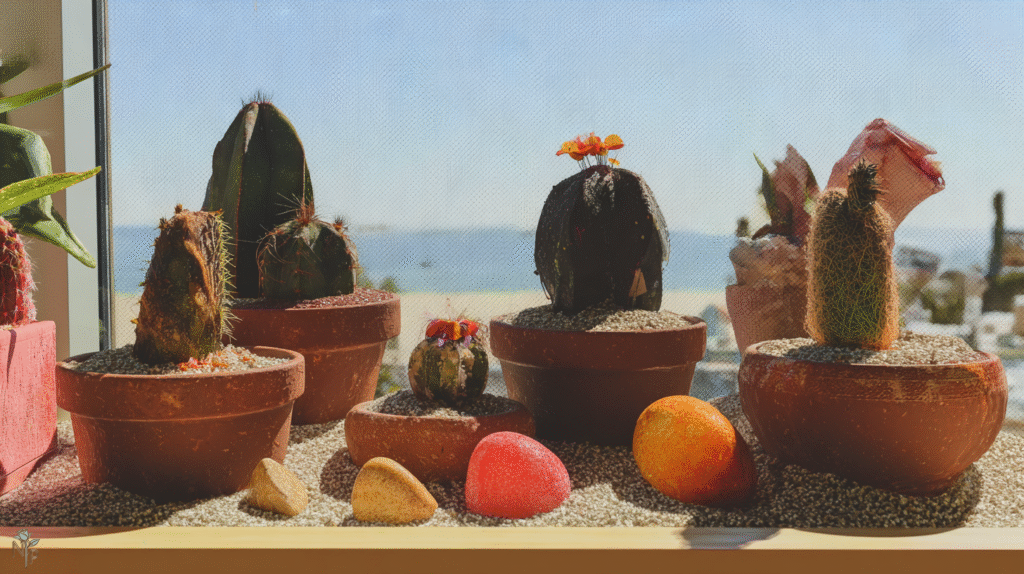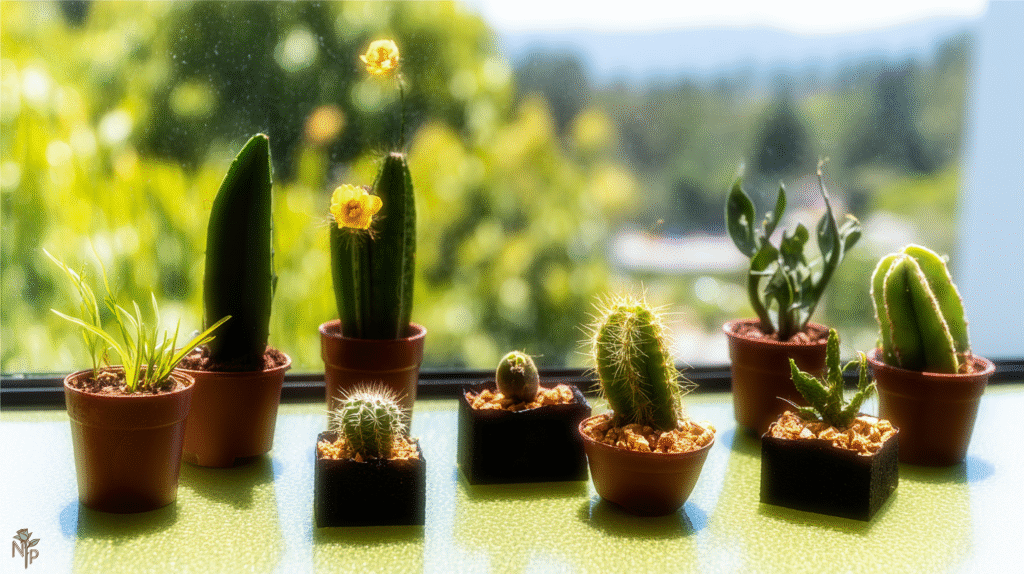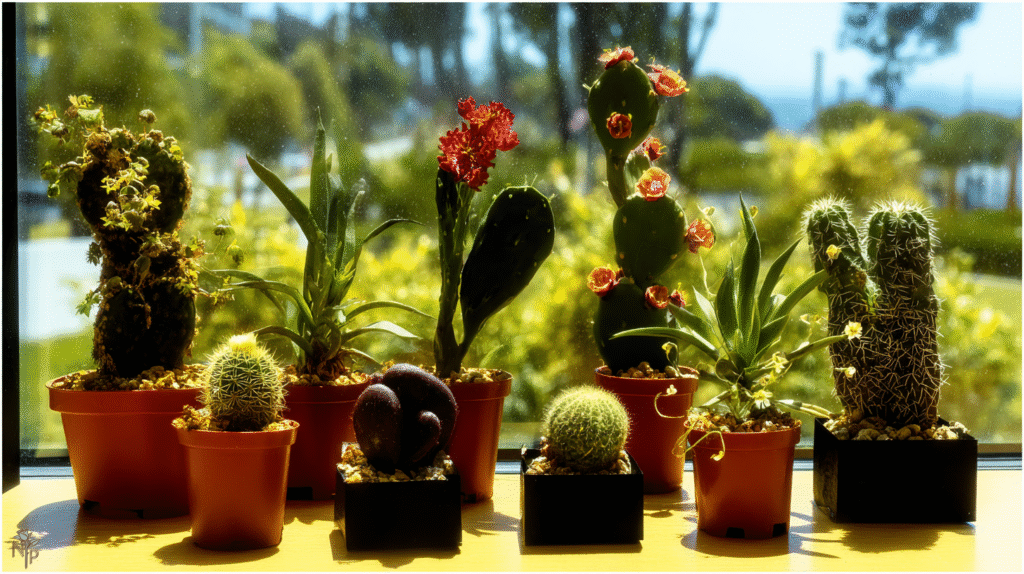“It’s a cactus,” my friend said, handing me a fuzzy ball in a cute pot. “You literally can’t kill it. They thrive on neglect!”
Eight weeks later, I was googling “why is my cactus yellow and squishy” while staring at what looked like a deflated tennis ball. Turns out, cacti don’t thrive on neglect — they thrive on the RIGHT kind of neglect. Big difference.
That murdered bunny ear cactus was the first of many casualties in my journey to understand what indoor cacti actually need versus what everyone thinks they need. Three years and approximately fifteen dead cacti later (I stopped counting after ten), I finally have a windowsill full of thriving, even blooming, cacti. Here’s what nobody told me about their weird, specific, absolutely non-negotiable needs.

The Desert Myth That Kills Indoor Cacti
Everyone thinks cacti want to recreate Death Valley in your living room. Hot, dry, forgotten about. Here’s the thing — your house isn’t a desert. It’s a climate-controlled box with weird humidity, no temperature swings, and windows that filter out UV rays. Your cactus knows the difference.
Desert conditions that cacti actually evolved for:
- Blazing sun for 12+ hours
- Massive temperature drops at night
- Months without rain, then sudden deluges
- Wind and air circulation constantly
- Intense UV radiation
Your apartment:
- Filtered light through windows
- Constant 72°F
- Random watering when you remember
- Stagnant air
- Zero UV getting through glass
No wonder they’re confused. We’re asking desert plants to live in conditions that are literally the opposite of home.
Light: The Non-Negotiable Requirement
This is where 90% of indoor cacti meet their doom. That “sunny windowsill” you think is bright? Your cactus disagrees.
What cacti actually need: Direct sun. Not bright indirect. Not “near a window.” Actual sun hitting actual cactus for 4-6 hours minimum. My cacti live pressed against south-facing windows like they’re trying to escape.
The etiolation disaster: My first barrel cactus lived on a shelf “near” a window. Within months, it went from round to oblong, reaching desperately for light. Etiolation — stretching for light — is irreversible. That cactus never recovered its shape.
Window direction matters:
- South-facing: Cactus paradise
- West-facing: Good second choice
- East-facing: Only for more tolerant species
- North-facing: Just buy a snake plant instead
The grow light game-changer: When I realized my apartment windows weren’t enough, I added grow lights. Basic LED panels, nothing fancy. The difference? My cacti went from surviving to actually growing. Some even bloomed — indoors! — which felt like winning the plant lottery.
Water: Where Good Intentions Become Murder
I killed more cacti with water than any other way. The issue? We water cacti like we water other houseplants — regularly, moderately, consistently. Cacti want flood or famine. Period.
My watering evolution:
Phase 1: Weekly water because “plants need water” Result: Root rot graveyard
Phase 2: Monthly water on a schedule Result: Still too much, slower death
Phase 3: The soil test method Result: Finally, living cacti!
What actually works:
- Stick a wooden skewer to the pot bottom
- Completely dry? Wait another week
- Then water thoroughly until it pours out drainage
- Don’t water again for 3-6 weeks (seriously)
In summer, mine get water every 3-4 weeks. In winter? I’ve gone 2-3 months. One forgot-about cactus went four months without water and bloomed to spite me.

Temperature: The Secret Nobody Mentions
Room temperature kills cactus blooms. There, I said it. Cacti need cool winter temperatures (50-55°F) to set buds. Kept at constant 72°F? They’ll live but never bloom.
My temperature breakthrough: Started moving cacti to my unheated spare room in winter. First year doing this? Five cacti bloomed in spring. FIVE. After years of flowerless existence.
Daily temperature swings matter too: Desert nights are cold. I crack the window near my cacti at night (not in winter — learned that the hard way). The 10-15 degree temperature drop mimics natural conditions.
Soil: The Foundation Everyone Gets Wrong
Regular potting soil is cactus murder juice. Even “cactus soil” from stores is usually too heavy.
My soil journey:
- Started with regular potting soil: 5 dead cacti
- Tried store “cactus mix”: Still lost 3
- Made my own mix: Success finally
The mix that actually works:
- 1 part potting soil
- 1 part coarse sand (not fine sandbox sand)
- 1 part perlite
- Handful of small gravel
Water should run through like a sieve. If it pools for even a second, add more perlite. This felt wrong at first — how can plants grow in hostile gravel? But cacti LOVE it.
Pots: The Silent Killer
That adorable glazed pot with no drainage hole? That’s a cactus coffin. The too-big pot you bought for them to “grow into”? Also death.
Pot rules that saved my cacti:
- Drainage holes: Non-negotiable, drill them yourself if needed
- Terracotta: Ugly but breathable
- Barely bigger than the cactus: They like tight spaces
- Shallow better than deep: Most cacti have shallow roots
I murdered a beautiful $30 moon cactus in a gorgeous ceramic pot. No drainage. Now all my cacti live in terracotta. Function over Instagram aesthetics.
The Dormancy Period Nobody Explains
Cacti need winter rest. Not “less water.” Actual dormancy with cool temperatures and almost no water. This was revolutionary for me.
Winter care that gets blooms:
- Move to coolest room (50-65°F ideal)
- Water maybe once the entire winter
- No fertilizer October through March
- Don’t panic when growth stops
First winter I did this, I thought I was killing them. Spring came, and they exploded with growth and flowers. Now I look forward to putting them to bed each winter.
Common Species and Their Quirks
Bunny ears (Opuntia): Forgiving except those glochids (tiny spines) are satan. Wear gloves always.
Barrel cacti: Need the most sun. Mine sits touching the window glass.
Christmas cactus: Not a desert cactus! Wants different everything. Don’t mix care.
Moon cactus: That colorful top? It’s grafted and will eventually die. Enjoy while it lasts.
Mammillaria: Easiest to bloom indoors. Good starter cactus.
Signs Your Cactus Is Struggling
Stretching/leaning: Desperate for light. Move immediately.
Yellow/translucent: Overwatered. Unpot, check roots, maybe salvageable.
Shriveled: Actually needs water (rare but happens).
Brown spots: Could be sunburn from too quick transition or fungal from overwatering.
No growth in summer: Needs more light or root-bound.
My Current Setup That Works
South window ledge: 6 various cacti pressed against glass Grow light shelf: 4 cacti that need extra sun Winter dormancy room: Unheated spare bedroom Watering can: Gathering dust (I water so rarely)
All in terracotta, all in gravelly mix, all on the “ignore until desert dry” schedule. The same varieties I killed before now thrive and bloom.

The Mental Shift Required
Success with indoor cacti requires accepting they’re not houseplants — they’re desert plants held hostage indoors. Stop treating them like philodendrons. Start treating them like the sun-worshipping, drought-loving, cold-winter-needing weirdos they are.
My windowsill went from a cactus graveyard to a spiky paradise once I understood their actual needs versus what I thought they needed. Less water, more sun, winter chill, hostile soil. Everything opposite of typical houseplant care.
That friend who gave me the “unkillable” cactus? She’s killed three since then. I’ve given her one of my propagations with actual care instructions. We’ll see if it survives. At least now I know it’s not the cactus’s fault when they die — it’s ours for not understanding what “low maintenance” actually means in cactus terms. 🌵






